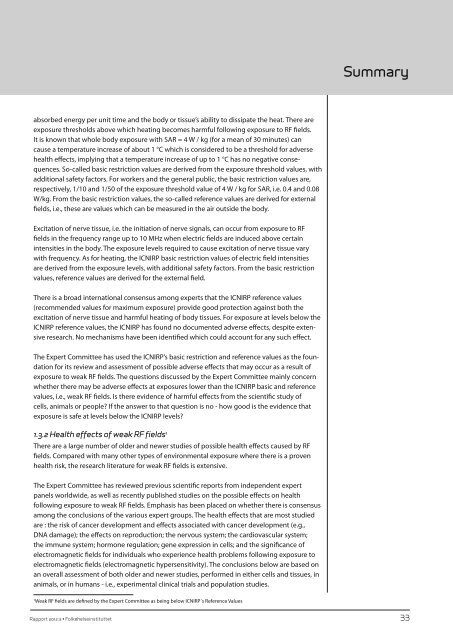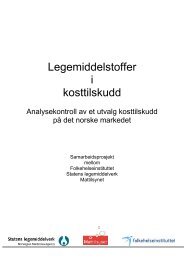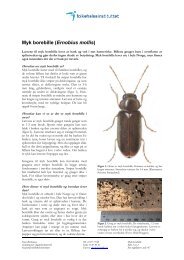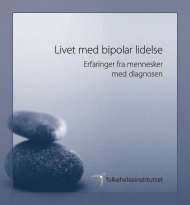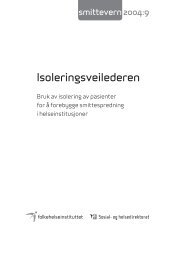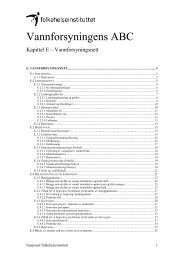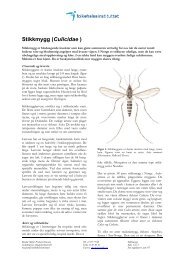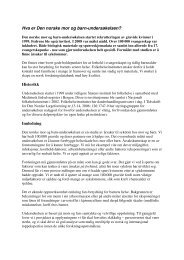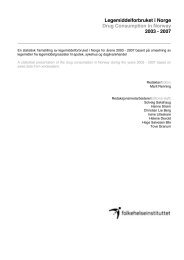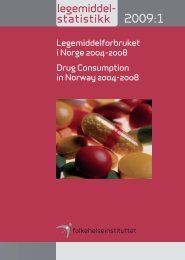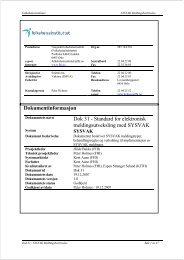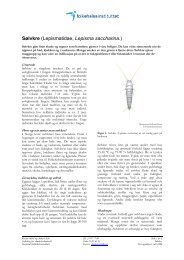rapport 2012:3 - Nasjonalt folkehelseinstitutt
rapport 2012:3 - Nasjonalt folkehelseinstitutt
rapport 2012:3 - Nasjonalt folkehelseinstitutt
Create successful ePaper yourself
Turn your PDF publications into a flip-book with our unique Google optimized e-Paper software.
absorbed energy per unit time and the body or tissue’s ability to dissipate the heat. There are<br />
exposure thresholds above which heating becomes harmful following exposure to RF fields.<br />
It is known that whole body exposure with SAR = 4 W / kg (for a mean of 30 minutes) can<br />
cause a temperature increase of about 1 °C which is considered to be a threshold for adverse<br />
health effects, implying that a temperature increase of up to 1 °C has no negative consequences.<br />
So-called basic restriction values are derived from the exposure threshold values, with<br />
additio nal safety factors. For workers and the general public, the basic restriction values are,<br />
respectively, 1/10 and 1/50 of the exposure threshold value of 4 W / kg for SAR, i.e. 0.4 and 0.08<br />
W/kg. From the basic restriction values, the so-called reference values are derived for external<br />
fields, i.e., these are values which can be measured in the air outside the body.<br />
Excitation of nerve tissue, i.e. the initiation of nerve signals, can occur from exposure to RF<br />
fields in the frequency range up to 10 MHz when electric fields are induced above certain<br />
intensities in the body. The exposure levels required to cause excitation of nerve tissue vary<br />
with frequency. As for heating, the ICNIRP basic restriction values of electric field intensities<br />
are derived from the exposure levels, with additional safety factors. From the basic restriction<br />
values, reference values are derived for the external field.<br />
There is a broad international consensus among experts that the ICNIRP reference values<br />
(recommended values for maximum exposure) provide good protection against both the<br />
excitation of nerve tissue and harmful heating of body tissues. For exposure at levels below the<br />
ICNIRP reference values, the ICNIRP has found no documented adverse effects, despite extensive<br />
research. No mechanisms have been identified which could account for any such effect.<br />
The Expert Committee has used the ICNIRP’s basic restriction and reference values as the foundation<br />
for its review and assessment of possible adverse effects that may occur as a result of<br />
exposure to weak RF fields. The questions discussed by the Expert Committee mainly concern<br />
whether there may be adverse effects at exposures lower than the ICNIRP basic and reference<br />
values, i.e., weak RF fields. Is there evidence of harmful effects from the scientific study of<br />
cells, animals or people? If the answer to that question is no - how good is the evidence that<br />
exposure is safe at levels below the ICNIRP levels?<br />
1.3.2 Health effects of weak RF fields1 There are a large number of older and newer studies of possible health effects caused by RF<br />
fields. Compared with many other types of environmental exposure where there is a proven<br />
health risk, the research literature for weak RF fields is extensive.<br />
The Expert Committee has reviewed previous scientific reports from independent expert<br />
panels worldwide, as well as recently published studies on the possible effects on health<br />
following exposure to weak RF fields. Emphasis has been placed on whether there is consensus<br />
among the conclusions of the various expert groups. The health effects that are most studied<br />
are : the risk of cancer development and effects associated with cancer development (e.g.,<br />
DNA damage); the effects on reproduction; the nervous system; the cardiovascular system;<br />
the immune system; hormone regulation; gene expression in cells; and the significance of<br />
electromagnetic fields for individuals who experience health problems following exposure to<br />
electromagnetic fields (electromagnetic hypersensitivity). The conclusions below are based on<br />
an overall assessment of both older and newer studies, performed in either cells and tissues, in<br />
animals, or in humans - i.e., experimental clinical trials and population studies.<br />
1 Weak RF fields are defined by the Expert Committee as being below ICNIRP´s Reference Values<br />
Summary<br />
Rapport <strong>2012</strong>:3 • Folkehelseinstituttet 33


